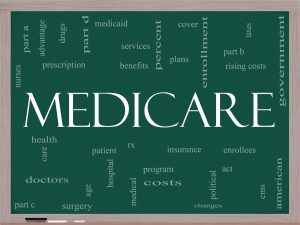 Let’s face it, Medicare insurance can be expensive. Original Medicare Part A is free due to earned work credits, but Part B costs nearly $150 a month for most.
Let’s face it, Medicare insurance can be expensive. Original Medicare Part A is free due to earned work credits, but Part B costs nearly $150 a month for most.
And Medicare Parts A & B only cover so much. There are still gaps like deductibles, coinsurance, prescriptions, dental, vision, hearing and so on.
So how do you fill these gaps, reduce your out-of-pocket, and not break the bank? Below we discuss six inexpensive ways to shore-up your Medicare coverage.
1) The Case For $0 Medicare Advantage Plans
Also referred to as Part C, Medicare Advantage plans offer an affordable way to strengthen your Medicare coverage with little or no premiums. There are some things to know first, however.
When choosing an Advantage plan, you’re turning your Medicare benefits over to a private insurance company like Aetna, Humana, UHC, or one of many others. This means you need to stay in their networks and use their doctors and hospitals. And these plans usually have more out of pocket exposure than staying on Original Medicare and purchasing a Medicare Supplement policy.
However, the good news is many Advantage plans have very low premiums. Several can be found for $0 a month. If your healthcare providers are in network, this coverage can be a good overall fit. And most policies also offer a wide array of ancillary benefits.
Most policies include prescription Part D drug coverage at no extra cost. It’s also common to see dental, vision and hearing benefits included as well. Still others include meals during recovery, quarterly stipends for medical supplies, and free transportation to doctor’s appointments.
All of these benefits can be found in many parts of the country for $0 a month. So that’s an all-in-one plan with nothing else to purchase. You may face more out of pocket exposure for major health issues, but the premiums and ancillary benefits are hard to beat.
2) Medicare Advantage With Part B Reimbursement
A new wrinkle to some Medicare Advantage plans (like the ones mentioned above) are those that offer Part B give back provision. We know government run Medicare is not free.
Most people are entitled to Part A at no cost, but almost everyone pays Part B premiums to the government each month.
However, when you enroll in certain Medicare Advantage plans (even those with $0 premiums), the insurance company will pay a portion (or all) of your monthly Part B premiums. The amount reimbursed varies, but it can be up to the full $148.50, however. This offers a tremendous savings to consumers.
You’ll of course want to make sure the plan is a good overall fit for your needs. Purchasing any Advantage plan on cost alone may be unwise, but reducing your premiums through Part B reimbursements is a great way to lower your monthly outlays.
These policies aren’t available everywhere, but they’re worth considering if you live in a county where one is offered.
3) Enroll In A Medicare Medical Savings Account
 Another new gift to the over 65 market are Medicare Medical Savings Accounts. These are high deductible $0 Medicare Advantage plans that offer a separate tax-advantaged account funded by the insurance company.
Another new gift to the over 65 market are Medicare Medical Savings Accounts. These are high deductible $0 Medicare Advantage plans that offer a separate tax-advantaged account funded by the insurance company.
The insurance company’s contributions always belong to you – even if you disenroll and choose different coverage later. You can spend your allocated funds on a tax-free basis for Qualified Medical Expenses. The coverage works much like a Health Savings Account for those under age 65.
Each year the insurance company contributes a couple thousand dollars to your account. These contributions could be used to meet the deductible, pay for prescriptions, vision & dental care, and a host of other items.
If you don’t utilize much healthcare, your savings account can grow significantly over time. The insurance company will continue to contribute each and every year. And by government rule, your premiums must remain at $0 a month.
The amount contributed depends on which policy you select and when during the year you sign-up. Contributions are prorated if you sign up in the middle of the year.
These no-network Advantage plans work well for savers in above average health who like to keep control of their finances. Medical Savings Accounts don’t include Part D drug coverage, so you will need to purchase that plan separately. Overall, there’s a lot to like about $0 MSA policies.
4) Inexpensive Medicare Supplement Coverage
If you’re worried about the network restrictions you can encounter with some Medicare Advantage plans, you might consider an inexpensive Medicare supplement plan. Depending on your age, gender and State of residence, you can often find Medigap plans for under $50 a month.
One such policy is High Deductible Plan G. It has a one-time, yearly deductible near $2,340 a year. Worst case scenario, that’s the most you would face in any given year. That’s much less out of pocket than several Medicare Advantage plans – and much less exposure than having nothing at all. All of that for a very reasonable price. We see a lot of interest in this particular policy.
And no matter which supplement you might choose, it’s wise to shop when your rates increase. Medical underwriting will likely be required, but it you pass, you can lower your rates dramatically. We help our clients shop whenever their rates increase significantly.
5) Keeping Tabs on Your Part D Drug Plan
If you own a Stand-Alone Part D Drug policy, then it can be advantageous to compare plans each Annual Election Period (AEP) in the fall. Failing to do so can cost you money. We see a lot of consumers with old Part D drug plans paying $50-$80 a month. Oftentimes a newer plan with much lower premiums would provide them with similar, if not better, coverage.
Insurance companies quietly change drug plans almost every year. Old policies are discontinued and you can get automatically mapped into a much more expensive plan if you’re not paying attention. This sometimes results in higher premiums, larger deductibles, and higher copays on your prescriptions.
If you have an older Stand-Alone Part D Drug plan, then it’s wise to shop for new coverage during the Medicare Annual Election Period. This window runs from October 15th thru December 7th each year. It’s usually the only time you can make this change and save money.
6) Low Income Subsidies & Extra Help
There are several programs available from Federal and State Governments for those below certain income thresholds. The Federal Government will send notification if you qualify for Low Income Subsidy – or LIS for short. This program works on a sliding scale and can reduce your Medicare premiums and/or out of pocket expenses.
Others may qualify for Medicaid. This is a state run program and consumers typically need to apply as this enrollment may not happen automatically. If you’re not sure about eligibility standards, call your State Medicaid office to discuss and apply.
Outside of Medicaid, there are other state-run programs that help with pharmaceutical costs. It’s wise to investigate those as well as any discounts you might receive from the drug manufacturers themselves. This information isn’t always volunteered, so you’ll need to inquire and apply. When and where provided, these programs can reduce costs significantly for those who qualify.
Contact Us For No Obligation & No Cost Insurance Assistance
The bottom line: The worst thing you can do is nothing. There are several no-cost and low premium plans that will reduce the gaps in your Medicare coverage. If you do nothing, you’ll likely be on the hook for much larger bills than if you had chosen one or more of the options above.
If you’re not sure which route might be best for you, contact us today. There is not cost whatsoever to use our services for guidance, advice and enrollment.